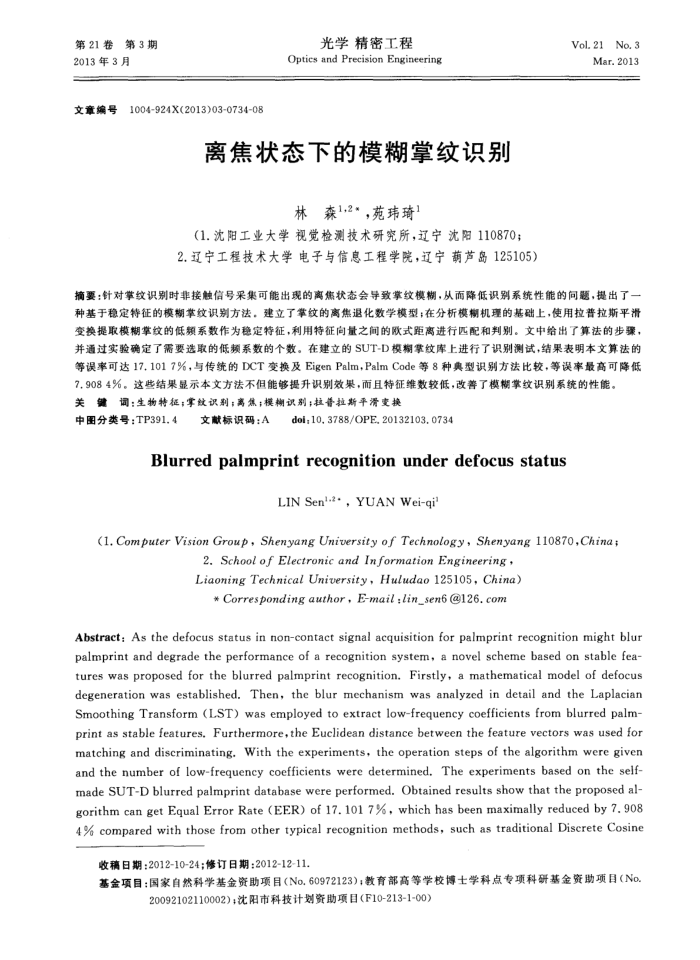您当前的位置:首页>论文资料>离焦状态下的模糊掌纹识别
内容简介
 第21卷第3期
第21卷第3期2013年3月文章编号
1004-924X(2013)03-0734-08
光学精密工程
Optics and Precision Engineering
离焦状态下的模糊掌纹识别
林森1,2*,苑玮琦1
(1.沈阳工业大学视觉检测技术研究所,辽宁沈阳110870; 2.辽宁工程技术大学电子与信息工程学院,辽宁荫芦岛125105)
Vol. 21No, 3
Mar.2013
摘要:针对掌纹识别时非接触信号采集可能出现的离焦状态会导致掌纹模糊,从而降低识别系统性能的间题,提出了一种基于稳定特征的模棚掌纹识别方法,建立了掌纹的离焦退化数学模型;在分析模棚机理的基础上,使用拉普拉斯平滑变换提取模糊掌纹的低频系数作为稳定特征,利用特征向量之间的欧式距离进行匹配和判别。文中给出了算法的步骤,并通过实验确定了需要选取的低频系数的个数。在建立的SUT-D模糊掌纹库上进行了识别测试,结果表明本文算法的等误率可达17.1017%,与传统的DCT变换及EigenPalm,PalmCode等8种典型识别方法比较,等误率最高可降低
7.9084%。这些结果显示本文方法不但能够提升识别效果,而且特征维数较低,改善了模棚掌纹识别系统的性能。关键词:生物特征;掌敏识别;离焦;模棚识别;拉普拉斯平滑变换
中图分类号:TP391.4
文献标识码:A
doi;10, 3788/OPE, 20132103, 0734
Blurredpalmprintrecognitionunderdefocusstatus
LIN Sen'-2·,YUAN Wei-qi'
(1.ComputerVisionGroup,ShenyangUniversityofTechnology,Shenyang110870,China;
2. School of Electronic and Information Engineering, LiaoningTechnicalUniversity,Huludao125105,China)*Correspondingauthor,E-mail:lin_sen6@126.com
Abstract: As the defocus status in non-contact signal acquisition for palmprint recognition might blur palmprint and degrade the performance of a recognition system, a novel scheme based on stable fea tures was proposed for the blurred palmprint recognition. Firstly, a mathematical model of defocus degeneration was established. Then, the blur mechanism was analyzed in detail and the Laplacian Smoothing Transform (LST) was employed to extract low-frequency coefficients from blurred palm-print as stable features. Furthermore,the Euclidean distance between the feature vectors was used for matching and discriminating. With the experiments, the operation steps of the algorithm were given and the number of low-frequency coefficients were determined. The experiments based on the self-made SUT-D blurred palmprint database were performed. Obtained results show that the proposed al-gorithm can get Equal Error Rate (EER) of 17. 101 7%, which has been maximally reduced by 7. 908 4% compared with those from other typical recognition methods, such as traditional Discrete Cosine
收稿日期:2012-10-24;修订日期:2012-12-11.
基金项目:国家自然科学基金资助项目(No.60972123);教育部高等学校博士学科点专项科研基金资助项目(No.
20092102110002);沈阳市科技计划资助项目(F10-213-1-00)